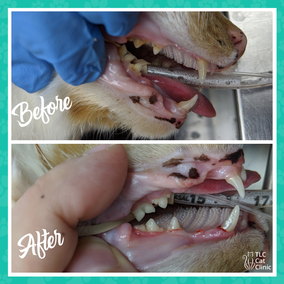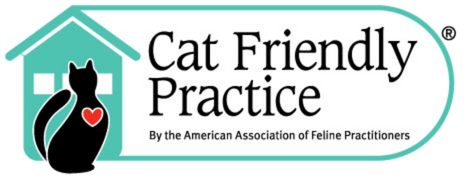|
Happy February! It’s amazing how quickly January flew by. Did you know February is National Pet Dental Health Month? Yes, even your feline friend needs dental care! The American Veterinary Dental Society estimates 70% of cats have some form of dental disease by the age of three.  While looking different, your feline’s teeth are not all that different than yours. Over the year, plaque and tartar build-up, which can lead to a whole host of problems. Not only can it cause an infection of the gums (gingivitis), but that infection can enter the bloodstream and travel to other organs. While daily brushing can help remove some of the build-up above the gumline, dental cleanings can help preserve your feline’s whole mouth and, ultimately, their health. Dental disease can be extremely painful for cats, and it may not always be detectable by foul-smelling breath. Because they can’t speak for themselves, the changes in their behavior, eating, and bathroom habits may indicate something is wrong and will require an examination to get to the root cause. Ways to Keep Your Cat’s Teeth Clean While we recommend brushing your cat’s teeth at home daily, that may be easier said than done. Some cats don’t mind it while others fight it tooth and claw. If you haven’t brushed your cat’s teeth before, now is the perfect time to start. We recommend working your way up to brushing, first by introducing them to the pet-safe toothpaste (not human toothpaste) on your finger. Dr. Shea recommends toothpaste from C.E.T. or Enzadent that come in a variety of flavors for cats. Once they’re comfortable with that, introduce the toothbrush with the toothpaste on it, letting them lick it off. From that point, focus on gently brushing the outside of your cat’s teeth. Dr. Shea typically doesn’t recommend brushing the inside of their teeth because they accumulate little tartar here and most cats won’t allow it. It will take patience, but it can be done! While brushing your cat’s teeth daily can certainly help, their diet can also play a big role in the health of their teeth. Choose a diet that carries the Veterinary Oral Health Council (VOHC) seal, which has been tested and certified by the council to remove plaque and/or tartar. You can also offer dental toys and treats to your cat that includes certain enzymes to help reduce plaque. Lastly, schedule your cat’s dental cleaning! At their annual exam, our doctors can see how much dental tartar has built up and sometimes lesions on the teeth that are painful and warrant an anesthetized dental cleaning to have the tooth removed.  What Happens During Your Cat’s Anesthetized Dental Procedure At TLC Cat Clinic, all dental procedures are performed with your feline under anesthesia. This is done to protect your pet as well as our team. It is also recommended by the American Animal Hospital Association (AAHA). After they’re under anesthesia, the exam is not unlike a human exam. We begin by assessing each tooth, gum line for pockets, and overall mouth for abnormalities. An ultrasonic scaler is then used to remove plaque and tartar on the tooth and under the gum line. Afterward, they are polished. We then perform x-rays of each tooth to rule out advanced issues, like infection, bone loss, and tooth resorption. Based on the x-rays and dental exam, we may recommend tooth extractions or oral surgeries if needed. We will call while your pet is under anesthesia to discuss our exam and x-ray findings, the recommended procedure, and the estimated cost with you before proceeding. If you have further questions about dental exams at TLC Cat Clinic, would like to discuss your feline’s oral care, or want to set up an appointment, please contact our clinic at 763-559-8787. Comments are closed.
|
Categories
All
Archives
November 2022
|
|
Plymouth Sun Sailor 2019 and 2020
Readers' Choice Best Veterinary Clinic |
Clinic Hours
Monday - 9:00 am - 6:00 pm Tuesday - 9:00 am - 6:00 pm Wednesday - 9:00 am - 6:00 pm Thursday - 9:00 am - 6:00 pm Friday - 9:00 am - 6:00 pm |
|
Site powered by Weebly. Managed by IDEXX Laboratories

 RSS Feed
RSS Feed



